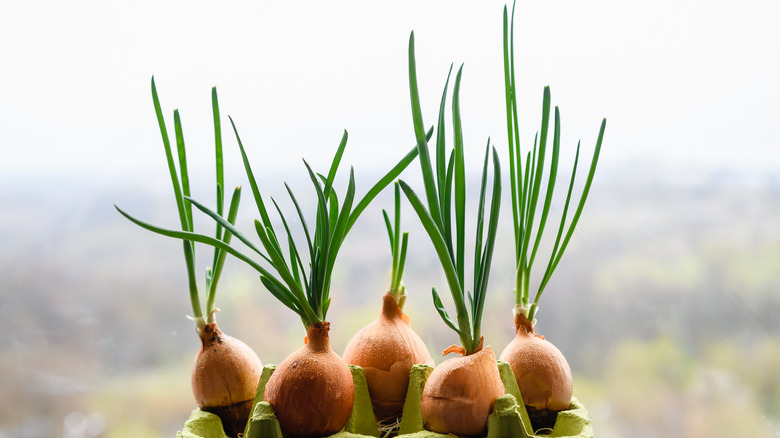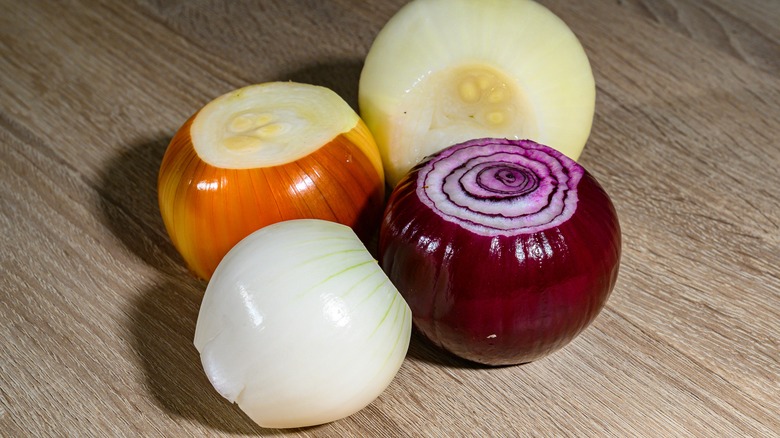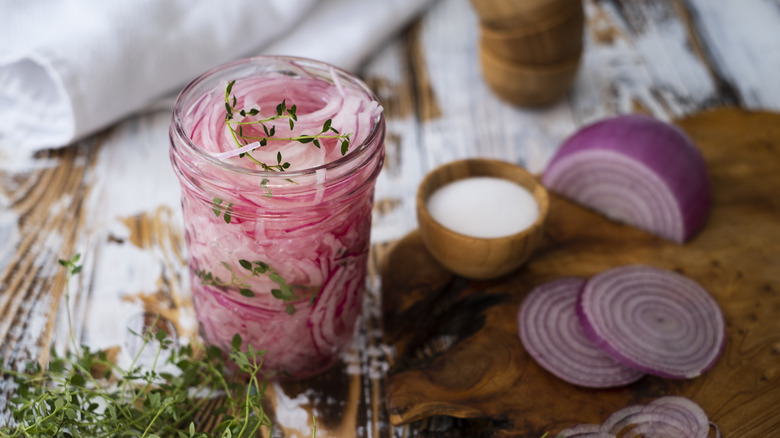Is It Safe To Eat Sprouted Onions?
Food waste is a major problem in America, with about 119 billion pounds of food wasted per year in the country. Though you can and should work to combat food waste in your own home, it's inevitable that some of the produce you buy will end up past its prime before you can use it. Part of dealing with waste is knowing when food has gone bad to the point where it's unsafe to eat, versus when it's a bit old, but still useable. With this difference in mind, you may wonder: What about an onion that has big green sprouts growing out of it? Should you avoid cooking with it, or can it be salvaged?
Properly storing onions can help you avoid having to face this question, but the short answer is that eating a sprouted onion is not going to hurt you, no matter what you might have heard (and people have a lot of misconceptions about onions). However, depending on how sensitive your palate is, using up these onions can be a little more difficult compared to using fresh ones. It all depends on how you feel about the fact that sprouted onions taste different.
It's obvious when an onion isn't good anymore
The thing about onions is that when they've truly gone bad, you're going to know. An onion that is completely past its prime is a much different beast than one that's simply sprouted. With a foul smell and a texture that may be dark and soft in some spots, or completely mushy and falling apart, there's no way to mistake a rotten onion for one that's still good. So if your sprouted onion otherwise appears normal, doesn't smell off, and feels hard and solid all around, it's not rotten.
A sprouted onion is still perfectly edible, as sprouting is a natural part of the onion's aging process. And unlike a lot foods, when onions get a bit old, their texture won't be affected. A sprouted onion will usually have the same mouthfeel as a totally fresh one. However, the flavor will be a bit different, becoming much more bitter and significantly less sweet, since the onion uses the sugar stored in its cells to create the sprout. This flavor shift can be unpleasant for some people, but doesn't render the onion unusable.
The other important thing to note is you should still use it as soon as possible, because while a sprouted onion isn't yet bad, it's a lot closer to it than a newer one. Sprouting is the first part of the process where onions become soft, then rancid, so use that onion before you use any others.
Use sprouted onions a bit differently
Due to the loss of sweetness and an increase in sharpness, a sprouted white onion is going to taste more like a red onion. If you really dislike red onions, you might be out of luck, but there are times when a sharper, more bitter onion works great in a dish. For any recipe where you'd want a more aggressive onion flavor — for example, in a vinegar-forward dish like pickled onions — sprouted onions can actually be superior to fresher ones. You can also mellow the flavor of a sprouted onion by rinsing or soaking it in water, which will absorb a lot of the pungent juice that comes out when an onion is cut. Another good option is removing the sprout itself, as that will negate some of the bitter flavor.
Ultimately, you can avoid wasting sprouted onions by learning how to use them in the best way, just like with any other kitchen ingredient. With a bit of creativity and understanding of how the flavor has changed, you don't need to throw old onions away and waste both money and food.


